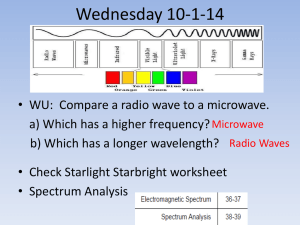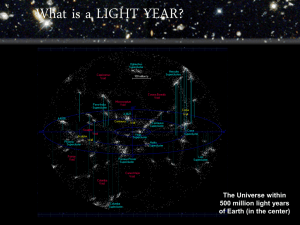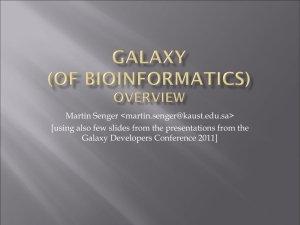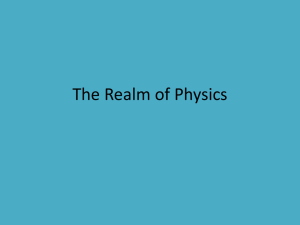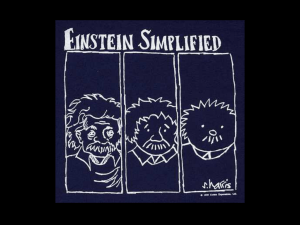Higher Physics: Hubble`s Law questions
advertisement
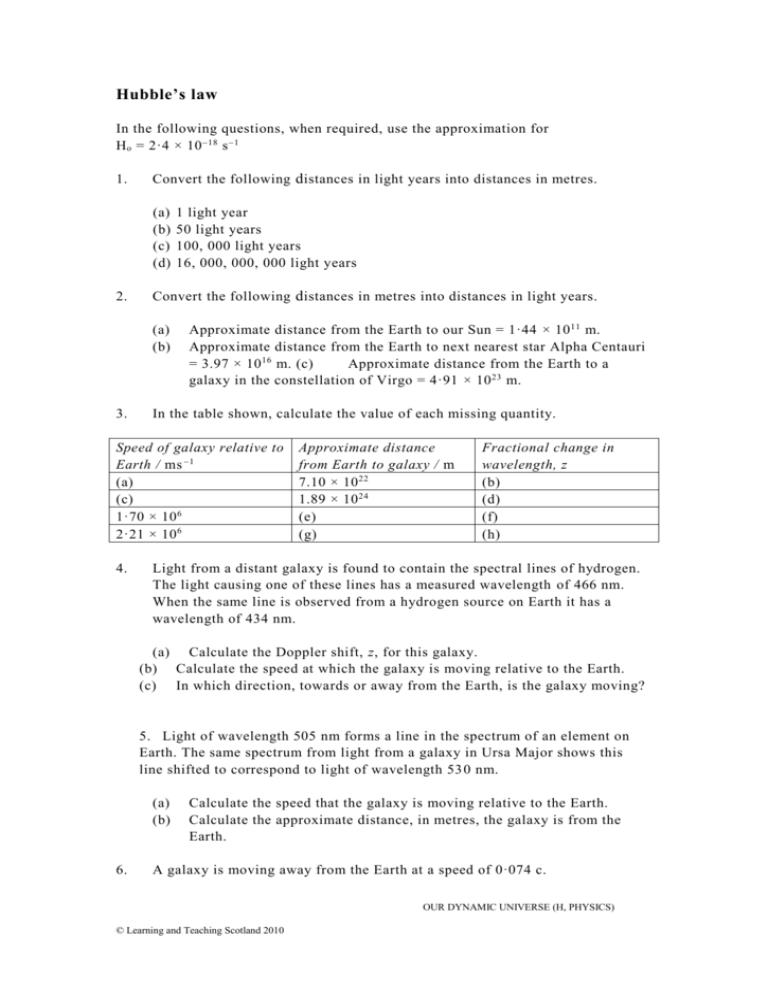
Hubble’s law In the following questions, when required, use the approximation for H o = 2·4 × 10 18 s 1 1. Convert the following d istances in light years into distances in metres. (a) (b) (c) (d) 2. Convert the following d istances in metres into distances in light years. (a) (b) 3. 1 light year 50 light years 100, 000 light years 16, 000, 000, 000 light years Approximate distance from the Earth to our Sun = 1·44 × 10 11 m. Approximate distance from the Earth to next nearest star Alpha Centauri = 3.97 × 10 16 m. (c) Approximate distance from the Earth to a galaxy in the constellation of Virgo = 4·91 × 10 23 m. In the table shown, calculate the value of each missing quantity. Speed of galaxy relative to Earth / m s 1 (a) (c) 1·70 × 10 6 2·21 × 10 6 4. Approximate distance from Earth to galaxy / m 7.10 × 10 22 1.89 × 10 24 (e) (g) Fractional change in wavelength, z (b) (d) (f) (h) Light from a distant galaxy is found to contain the spectral lines of hydrogen. The light causing one of these lines has a measured wavelength of 466 nm. When the same line is observed from a hydrogen source on Earth it has a wavelength of 434 nm. (a) Calculate the Doppler shift, z, for this galaxy. (b) Calculate the speed at which the galaxy is moving relative to the Earth. (c) In which direction, towards or away from the Earth, is the galaxy moving? 5. Light of wavelength 505 nm forms a line in the spectrum of an element on Earth. The same spectrum from light from a galaxy in Ursa Major shows this line shifted to correspond to light of wavelength 53 0 nm. (a) (b) 6. Calculate the speed that the galaxy is moving relative to the Earth. Calculate the approximate distance, in metres, the galaxy is from the Earth. A galaxy is moving away from the Earth at a speed of 0·074 c. OUR DYNAMIC UNIVERSE (H, PHYSICS) © Learning and Teaching Scotland 2010 7. (a) Convert 0·074 c into a speed in m s 1 . (b) Calculate the approximate distance, in metres, of the galaxy from the Earth. A distant star is travelling directly away from the Earth at a speed of 2·4 × 10 7 m s 1 . (a) Calculate the value of z for this star. (b) A hydrogen line in the spectrum of light from this star is measured to be 443 nm. Calculate the wavelength of this line when it observed from a hydrogen source on the Earth. 8. A line in the spectrum from a hydrogen atom has a wavelength of 489 nm on the Earth. The same line is observed in the spectrum of a distant star but with a longer wavelength of 538 nm. (a) (b) Calculate the speed, in m s 1 , at which the star is moving away from the Earth. Calculate the approximate distance, in metres and in light years, of the star from the Earth. 9. The galaxy Corona Borealis is approximately 1 000 million light years away from the Earth. Calculate the speed at which Corona Borealis is moving away from the Earth. 10. A galaxy is moving away from the Earth at a speed of 3·0 × 10 7 m s 1 . The frequency of an emission line coming from the galaxy is measured. The light forming the same emission line, from a source on Earth, is observed to have a frequency of 5·00 × 10 14 Hz. (a) Show that the wavelength of the light corresponding to the emiss ion line from the source on the Earth is 6·00 × 10 7 m. (b) Calculate the frequency of the light forming the emission line coming from the galaxy. 11. A distant quasar is moving away from the Earth. Hydrogen lines are observed coming from this quasar. One of these lines is measured to be 20 nm longer than the same line, of wavelength 486 nm from a source on Earth. (a) (b) Calculate the speed at which the quasar is moving away from the Earth. Calculate the approximate distance, in millions of light years, that the quasar is from the Earth. 12. A hydrogen source, when viewed on the Earth, emits a red emission line of wavelength 656 nm. Observations, for the same line in the spectrum of light from a distant star, give a wavelength of 660 nm. Calculate the speed of t he star relative to the Earth. OUR DYNAMIC UNIVERSE (H, PHYSICS) © Learning and Teaching Scotland 2010 13. Due to the rotation of the Sun, light waves received from opposite ends of a diameter on the Sun show equal but opposite Doppler shifts. The relative speed of rotation of a point on the end of a diameter of the Sun rel ative to the Earth is 2 km s 1 . Calculate the wavelength shift for a hydrogen line of wavelength 486·1 nm on the Earth Hubble’s law × × × × 10 15 10 17 10 20 10 26 1. (a) (b) (c) (d) 9·46 4·73 9·46 1·51 m m m m 2. (a) (b) (c) 1·52 × 10 5 light years 4·2 light years 5·19 × 10 7 light years 3. 4. v / m s 1 d/m z 1·70 × 10 5 7·10 × 10 22 5·67 × 10 4 4·54 × 10 6 1·89 × 10 24 1·51 × 10 2 1·70 × 10 6 7·08 × 10 23 5·667 × 10 2 2·21 × 10 6 9·21 × 10 23 7·37 × 10 3 10 2 10 7 m s 1 (a) (b) (c) (a) (b) 7·37 × 2·21 × Away 1·49 × 6·21 × 6. (a) (b) 2·22 × 10 7 m s 1 9·25 × 10 24 m 7. (a) (b) 8 × 10 2 410 nm 8. (a) (b) 3·0 × 10 7 m s 1 1·25 × 10 25 m, 1·32 × 10 9 light years 9. 2·27 × 10 7 m s 1 10. (b) 4·55 × 10 14 Hz 11. (a) (b) 1·23 × 10 7 m s 1 542 million light years 5. 10 7 m s 1 10 24 m OUR DYNAMIC UNIVERSE (H, PHYSICS) © Learning and Teaching Scotland 2010 12. 1·83 × 10 6 m s 1 13. 3·24 × 10 12 m OUR DYNAMIC UNIVERSE (H, PHYSICS) © Learning and Teaching Scotland 2010
